
A Comprehensive Guide to Employee Development: Nurturing Growth and Success
June 12 – 2023
Employee development is a critical aspect of building a thriving and engaged workforce. By investing in the growth and professional advancement of employees, organizations can enhance productivity, retention, and overall business success.
In this comprehensive guide, we will explore the key components and strategies for effective employee development, empowering you to create a culture of continuous learning and growth within your organization.
Step 1: Assess Individual and Organizational Needs
To kickstart a successful employee development program, it is essential to assess both individual and organizational needs. Identify the skills, knowledge, and competencies required for employees to excel in their roles and align them with the strategic goals of the organization. Conduct performance evaluations, surveys, and interviews to gather insights and prioritize areas for development.
Step 2: Create Individual Development Plans
Individual Development Plans (IDPs) serve as roadmaps for employees’ professional growth. Collaborate with employees to create tailored IDPs that align their aspirations and development goals with organizational objectives. Ensure that IDPs include a mix of short-term and long-term goals, along with specific action steps and timelines for achieving them.
Step 3: Provide Learning Opportunities
Offer a variety of learning opportunities to cater to different learning styles and preferences. These can include workshops, seminars, conferences, webinars, online courses, coaching, mentoring, and job rotations. Encourage employees to take ownership of their development by providing them with access to relevant resources, such as e-learning platforms and industry publications.
Step 4: Foster a Learning Culture
Cultivate a culture of continuous learning and development within your organization. Encourage knowledge sharing, collaboration, and peer-to-peer learning through internal networks, communities of practice, and cross-functional projects. Recognize and reward employees who actively participate in learning activities and demonstrate a commitment to their professional growth.
Step 5: Support Coaching and Mentoring
Implement coaching and mentoring programs to provide employees with guidance and support in their development journey. Pair experienced employees with those seeking to enhance specific skills or advance in their careers. This one-on-one guidance fosters knowledge transfer, skill-building, and personal growth, benefiting both mentors and mentees.
Step 6: Encourage Stretch Assignments
Offer employees stretch assignments that challenge them beyond their current roles and responsibilities. These assignments provide opportunities for skill development, creativity, and innovation. By taking on new and unfamiliar tasks, employees can expand their capabilities and gain valuable experiences that contribute to their professional development.
Step 7: Performance Feedback and Evaluation
Regularly provide constructive feedback and conduct performance evaluations to help employees track their progress and identify areas for improvement. Transparent and timely feedback fosters a growth mindset and enables individuals to make necessary adjustments to their development plans. It also reinforces the organization’s commitment to employee growth.
Step 8: Support Career Development
Employee development is closely linked to career advancement. Support employees’ career aspirations by providing growth opportunities, such as promotions, lateral moves, and specialized training. Create a clear career progression framework that outlines the skills and experiences required for advancement, enabling employees to chart their career paths within the organization.
Step 9: Measure and Evaluate
Establish metrics and evaluation methods to assess the effectiveness of your employee development initiatives. Measure indicators such as increased employee engagement, improved performance, reduced turnover, and enhanced skill levels. Regularly review the outcomes and adjust your strategies as needed to ensure ongoing success.
Step 10: Continuous Improvement
Employee development is an ongoing process that requires continuous improvement. Stay updated on industry trends, emerging technologies, and evolving skill requirements. Adapt your development programs to address changing needs and leverage feedback from employees to refine and enhance your initiatives.
In conclusion
Employee development is a key driver of individual growth and organizational success. By investing in the development of your employees, you cultivate a skilled and engaged workforce that contributes to increased productivity, innovation, and employee satisfaction. Implement the strategies outlined in this guide, tailor them to your organization’s unique needs, and foster a culture of continuous learning and development to unlock the full potential of your employees and drive long-term success.
Publication date
June 12 – 2023
Similar articles
Book a Demo & Receive Consultation
Take the first step towards unlocking your organization’s full potential. Book a demo today and discover how our product can drive growth, boost productivity and exceed your expectations. We look forward to have this meeting with you!


